The demand for chickpea flour in the EU is expected to grow from USD 545.2 million in 2025 to USD 1,072.5 million in 2035, reflecting a CAGR of 7.0%. Market share dynamics are likely to shift as consumer preferences for plant-based and protein-rich diets expand.
As highlighted in FMI’s comprehensive report on global dietary behavior and flavor adoption patterns, companies offering high-quality, organic, or fortified chickpea flour are positioned to gain a larger share, while players with limited product differentiation or lower quality standards may see gradual erosion. Growth is expected to be supported by increasing adoption in bakery, snack, and ready-to-eat food products, as well as rising awareness of gluten-free and vegan alternatives.
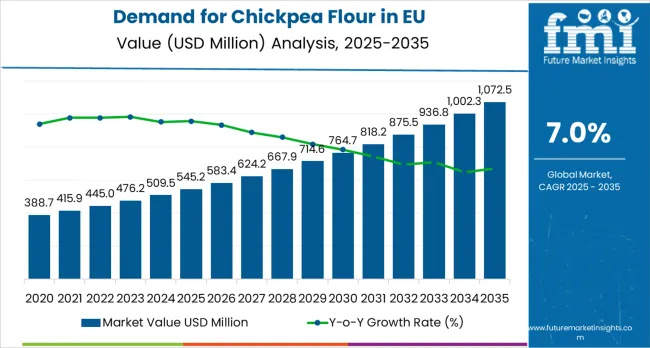
The European Union's chickpea flour industry is growing steadily, driven by the rising popularity of plant-based, gluten-free, and protein-rich diets. In 2025, the market is estimated to reach approximately USD 550 million, with a projected annual growth rate of around 6% over the next five years.
Conventional chickpea flour dominates the market, accounting for roughly 85-87% of total consumption, due to its wide availability and cost-effectiveness. The remaining share is held by organic and specialty variants, which are gaining traction among health-conscious consumers.
Between 2025 and 2030, market share gains are anticipated for producers focusing on innovative product lines and strong distribution networks. Early movers in organic and specialty chickpea flour segments are likely to secure a competitive advantage, while smaller or regional players may face pressure to upgrade offerings. From 2030 to 2035, the market may witness further gains by companies leveraging branding, product diversification, and e-commerce channels, while those failing to innovate could lose influence.
The analysis indicates that the EU chickpea flour industry will experience net share growth for companies emphasizing quality, innovation, and market reach, with a gradual decline for players unable to adapt to evolving consumer preferences and regulatory expectations.
Recent trends indicate increasing adoption of chickpea flour in bakery, snack, and ready-to-eat products, representing around 70% of its end-use consumption. The food service and home cooking segments account for the remaining 30%, reflecting growing household and restaurant usage.
There is also a noticeable shift toward fortified and non-GMO chickpea flour, capturing approximately 15-20% of new product launches. Rising demand for clean-label, high-protein, and allergen-friendly alternatives continues to drive innovation and expansion across the European market.
Market expansion is being supported by the fundamental shift in consumer attitudes toward plant-based nutrition and gluten-free dietary solutions across European societies, with chickpea flour increasingly regarded as superior nutritional ingredients deserving premium positioning, natural processing methods, and overall health benefits comparable to traditional wheat flour while providing unique protein and fiber advantages.
Modern European consumers and culinary professionals consistently prioritize nutritional density, gluten-free properties, protein content, and culinary versatility when selecting alternative flours, driving demand for specialty chickpea flour formulations that deliver superior nutritional performance, natural processing methods, exceptional cooking properties, and health certifications compared to conventional wheat-based flours.
Even minor concerns about gluten sensitivity, protein adequacy, or culinary innovation can drive comprehensive adoption of specialized premium chickpea flour products designed to maintain optimal nutritional intake, support specific dietary applications, and enhance overall culinary satisfaction throughout all cooking categories.
The growing complexity of alternative nutrition and increasing awareness of chickpea-specific benefits are driving demand for professionally processed chickpea flour products from certified European manufacturers with appropriate food safety certifications, processing capabilities, technical expertise, and compliance with stringent EU food safety regulations.
Regulatory authorities across European Union member states are increasingly establishing comprehensive guidelines for alternative flour manufacturing, nutritional claim accuracy, labeling requirements, and food safety protocols to ensure product effectiveness and consumer safety.
Scientific research studies and nutritional analysis conducted at European food science research institutions are providing evidence supporting chickpea flour interventions for common dietary challenges including gluten avoidance, protein supplementation, fiber enhancement, and overall nutritional optimization, requiring specialized processing expertise and food-grade production processes that meet EU food safety standards.
The market is segmented by product type, product claims, distribution channel, and sales region. By product type, the market is divided into desi chickpea flour (including small, dark varieties with higher fiber content) and kabuli chickpea flour (including large, light-colored varieties with milder flavor).
Based on product claims, the market is categorized into conventional (including standard processing methods and traditional formulations) and organic/non-GMO (including certified organic production and non-genetically modified varieties).
By distribution channel, the market spans specialty stores (health food retailers, ethnic food stores), supermarkets/hypermarkets, and online retail (e-commerce platforms, direct-to-consumer websites). Regionally, the market covers Germany, France, Italy, Spain, Netherlands, and Rest of Europe.
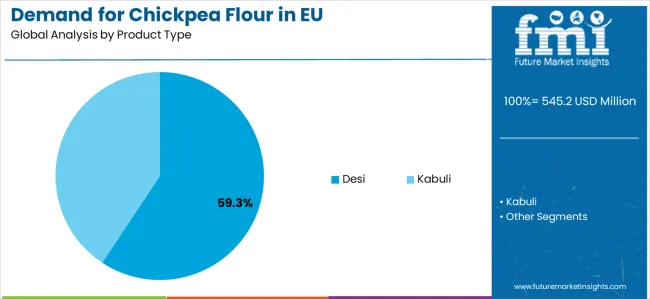
Desi chickpea flour segment is projected to account for 59.3% of the Demand for Chickpea Flour in EU in 2025, establishing itself as the dominant product category across European health food and ethnic cuisine facilities. This commanding market position is fundamentally supported by the widespread adoption of desi varieties for traditional ethnic cooking applications, superior nutritional density, and specialized culinary properties that deliver exceptional flavor profiles, enhanced nutritional content, and unparalleled cooking versatility throughout large-scale commercial and home cooking operations across EU member states.
Desi chickpea flour products provide European consumers with unparalleled nutritional benefits, authentic taste experiences, superior protein content, and seamless integration with traditional ethnic recipes that comply with authentic cooking methods and cultural food preferences.
This product sophistication enables European pulse processors to achieve optimal nutritional economics while maintaining traditional processing protocols that preserve authentic taste characteristics, comprehensive quality systems supporting ethnic cuisine authenticity, and consistent nutritional performance across millions of individual cooking applications produced annually.
The segment derives substantial competitive advantages from established ethnic cuisine traditions offering authentic recipe applications, comprehensive nutritional support services, and continuous product innovation that incorporates traditional processing technologies, improved nutritional characteristics, and authentic flavor capabilities aligned with ethnic cooking standards. The desi systems deliver superior nutritional positioning particularly important in health-conscious cooking markets, enhanced protein profiles, improved ethnic cuisine authenticity, and superior cultural compliance with traditional cooking methods.
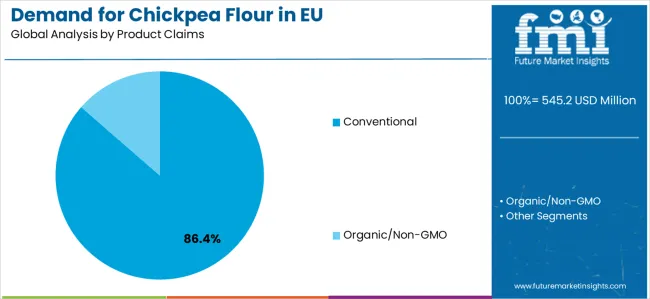
Conventional product claims applications are positioned to represent 86.4% of total European chickpea flour demand in 2025, reflecting the segment's dominant position within the overall market ecosystem and the substantially larger mainstream consumption patterns compared to specialty organic categories across most European countries. This substantial market share directly demonstrates the exceptionally high adoption rates of conventional chickpea flour among European mainstream consumers and the continuously expanding population of general health-conscious cooking across both Western and Eastern European markets.
Modern European conventional chickpea flour applications are increasingly featuring enhanced processing techniques that deliver improved nutritional retention, consistent quality standards, and specialized functional properties specifically designed to address common cooking challenges including texture optimization, flavor balance, shelf-life extension, and culinary versatility enhancement.
European consumers consistently demonstrate willingness to invest in premium conventional chickpea flour that delivers visible cooking benefits, supports optimal culinary outcomes, complies with EU food safety standards, and provides consistent results for both home cooking and commercial food preparation operations. Within the conventional segment, standard processing applications command 60% share, enhanced processing represents 20%, and specialty conventional formulations account for 6.4%, reflecting comprehensive processing segmentation strategies tailored to European cooking market preferences.
The demand for chickpea flour in EU is advancing steadily due to intensifying gluten-free dietary trends and growing recognition of plant-based protein benefits across EU member states. The market faces challenges including fluctuating chickpea commodity prices and supply chain constraints, complex organic certification requirements across diverse European jurisdictions, varying consumer awareness levels regarding chickpea flour applications, competition from other alternative flours including lentil, pea, and almond flours, and varying culinary adoption rates across different EU countries despite growing health consciousness trends. Innovation initiatives, culinary education programs, processing enhancement solutions, and health positioning platforms continue to influence product development strategies and market evolution patterns across European food markets.
The rapidly accelerating adoption of gluten-free dietary approaches and dietary inclusivity consciousness is fundamentally enabling broader market acceptance across European countries, enhanced dietary flexibility among consumers particularly regarding gluten sensitivity and celiac disease management, and significantly improved product accessibility through mainstream retail integration.
Advanced gluten-free education platforms operated by specialized dietary organizations, professional nutritionists, and major health food retailers equipped with comprehensive dietary guidance in multiple European languages, gluten-free certifications, cooking guides, and nutritional recommendations provide extensive educational resources while dramatically expanding product credibility across diverse health-conscious segments and geographic markets throughout the European Union.
These gluten-free trends prove particularly valuable for chickpea flour products that require detailed dietary compatibility documentation, nutritional benefit verification, and targeted marketing approaches to effectively communicate complex health benefits and justify premium pricing positions across sophisticated European health-conscious cooking segments. Gluten-free adoption also enables sophisticated dietary analytics, personalized nutrition recommendations based on individual dietary restrictions and health goals, direct consumer feedback collection that informs product development, and inclusive dietary models that ensure accessibility while building consumer loyalty across fragmented European dietary markets.
Progressive European consumers are systematically incorporating innovative ethnic cuisine exploration including Middle Eastern, Indian, Mediterranean, and North African cooking traditions that address growing European cultural curiosity about authentic flavors, traditional cooking methods, and diverse culinary experiences in home cooking applications.
Strategic integration of these ethnic cuisine approaches, combined with authentic recipe sharing and cultural cooking education conducted at European culinary institutions, enables consumers to develop sophisticated culinary propositions that appeal to culturally curious European food enthusiasts while maintaining authentic cooking characteristics and traditional flavor profiles.
These cultural initiatives also support development of specialized applications for specific ethnic recipes increasingly recognized across European cooking communities, enhanced flavor options for traditional ethnic dishes recommended by European chefs, and authentically-sourced products that resonate with cultural appreciation segments particularly prevalent in cosmopolitan and Western European cities.
Cultural investment in ethnic cuisine education facilities established in major European urban centers, authentic recipe development capabilities, and traditional cooking technique preservation enable European consumers to explore diverse culinary traditions while maintaining respect for authentic cultural cooking methods.
European health-conscious consumers and food manufacturers are increasingly prioritizing plant-based protein sources and nutritional enhancement when selecting alternative flour ingredients, driving fundamental changes in dietary strategies across the European health food industry. Companies are implementing comprehensive plant-based nutrition programs using sustainable protein sourcing, reducing animal protein dependency through plant-based alternative development, and developing nutritionally complete flour solutions that align with EU dietary guidelines and sustainable nutrition regulations.
This trend is particularly pronounced across Nordic countries, Germany, Netherlands, and France where consumers demonstrate exceptional nutrition consciousness and willingness to invest in ingredients with verified protein content and nutritional enhancement credentials.
Manufacturers are responding by developing partnerships with certified sustainable chickpea suppliers, implementing nutritional enhancement programs, obtaining multiple protein certification standards including plant-based nutrition and complete amino acid profiles, and providing comprehensive nutritional information that differentiates their products in increasingly competitive European markets emphasizing plant-based nutrition and dietary completeness commitments.
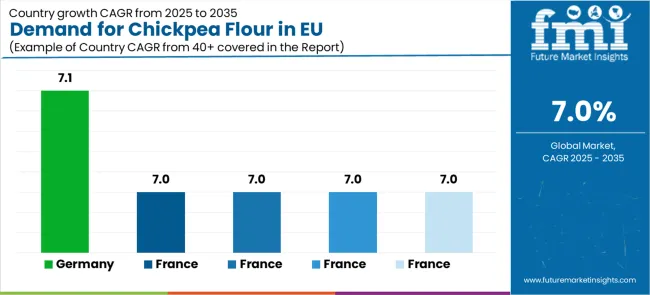
The demand for chickpea flour in EU is projected to grow from USD 545.2 million in 2025 to USD 1,072.5 million by 2035, registering a CAGR of 7.0% over the forecast period. Germany is expected to maintain its leadership with a 26.3% share in 2025, supported by its expansive health food infrastructure and strong tradition of alternative dietary product consumption.
France follows with a 19.4% market share, attributed to growing demand for gluten-free and ethnic cuisine ingredients. Italy contributes 13.9% of the market, driven by increasing adoption in Mediterranean cooking and health-conscious food preparation. Spain accounts for 9.7% of the market, while Netherlands represents 4.2%. The Rest of Europe region holds the remaining market share, encompassing Nordic countries, Eastern Europe, and other EU member states with emerging demand for chickpea flour products.
| Country | CAGR (2025 to 2035) |
|---|---|
| Germany | 7.1% |
| France | 7.0% |
| Italy | 7.0% |
| Spain | 7.0% |
| Netherlands | 7.0% |
The demand for chickpea flour in EU demonstrates consistent growth across major economies, with Germany leading at a 7.1% CAGR through 2035, driven by strong health food culture and gluten-free dietary adoption. France, Italy, Spain, and Netherlands maintain steady growth at 7.0%, supported by increasing health consciousness and ethnic cuisine integration. Rest of Europe shows a slight decline at -0.5% CAGR, reflecting market consolidation in emerging markets. The Germany maintains its leadership position while major Western European countries show uniform strong growth momentum.
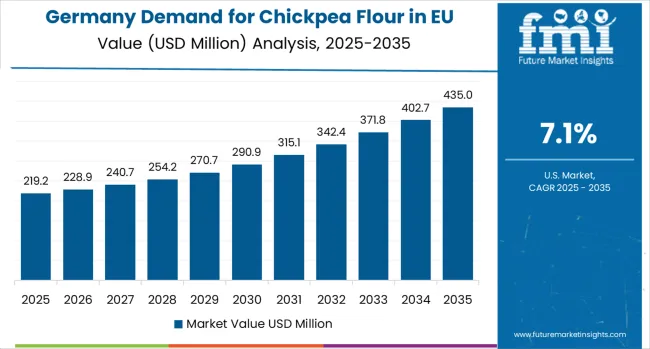
The demand for chickpea flour in Germany is projected to exhibit steady growth with a CAGR of 7.1% through 2035, driven by exceptionally strong consumer tradition in health food products and dietary alternatives, comprehensively well-established distribution networks for gluten-free and specialty ingredients, and sophisticated regulatory frameworks supporting alternative food quality standards throughout the country.
Germany's advanced health food regulations and internationally recognized dietary standards through organizations including German Nutrition Society are creating substantial demand for certified premium chickpea flour products across diverse consumer and culinary segments.
Major health food companies including German specialty retailers, specialized alternative flour manufacturers including organic producers, and professional distribution networks are systematically establishing extensive product portfolios serving both health-conscious consumers and culinary professionals throughout German retail centers, health food stores, and cooking communities.
The German market benefits from exceptionally high consumer awareness of gluten-free dietary solutions, substantial alternative flour retail presence, strong health food distribution programs delivering variety at competitive pricing, and cultural emphasis on dietary health that naturally support premium chickpea flour adoption.
The chickpea flour industry in France is expanding at a steady CAGR of 7.0%, substantially supported by increasing French consumer interest in ethnic cuisine exploration and premium culinary ingredients, growing awareness of gluten-free cooking benefits, and sophisticated appreciation for culinary innovation reflecting French gastronomic culture.
France's well-established culinary tradition and premium positioning strategies across food sectors are systematically driving demand for high-quality chickpea flour across diverse culinary and health-focused segments. Specialized culinary suppliers including French gourmet ingredient firms, traditional specialty food retailers, major hypermarket chains (Carrefour, Auchan, Leclerc), and professional culinary schools are establishing comprehensive ingredient ranges featuring premium imported and French-distributed chickpea flour emphasizing culinary quality and cooking versatility.
The French market particularly benefits from strong cultural emphasis on culinary innovation traditions, ethnic cuisine appreciation techniques, and gourmet ingredient methods that align perfectly with chickpea flour positioning as essential culinary components for sophisticated cooking experiences.
The chickpea flour industry in Italy is growing at a consistent CAGR of 7.0%, fundamentally driven by increasing integration of chickpea flour into traditional Italian cooking patterns, growing recognition of Mediterranean diet enhancement benefits, and strong Italian cultural appreciation for authentic ingredient solutions and traditional food preparation values.
Italy's deeply established culinary culture is systematically incorporating chickpea flour to enhance traditional recipes, improve nutritional profiles, and modernize classic Italian cooking approaches while maintaining authentic regional food characteristics.
Specialty food stores, specialized culinary ingredient distributors including Italian suppliers, leading grocery retailers (Coop, Esselunga, Conad), and traditional ingredient suppliers are strategically investing in culinary education programs and cooking demonstrations addressing growing Italian interest in alternative flour solutions. The Italian market particularly benefits from strong cultural appreciation for ingredient authenticity, traditional cooking approaches reflecting established Italian culinary traditions, and growing culinary innovation particularly in Northern Italian regions supporting premium ingredient adoption.
The chickpea flour industry in Spain is projected to grow at a steady CAGR of 7.0%, substantially supported by expanding health-conscious cooking sector that actively promotes alternative flour applications, increasing Spanish consumer awareness of gluten-free benefits, and growing culinary consciousness particularly in major metropolitan areas including Madrid, Barcelona, Valencia, and Seville. Spanish health food sector is experiencing steady development with expansion of health food retailers, premium ingredient suppliers, and major grocery distributors maintaining consistent chickpea flour category investments and steady premium ingredient availability.
The Spanish market is characterized by health food trends reflecting broader European patterns, growing interest in chickpea flour formulations addressing specific dietary applications, and consistent acceptance of alternative ingredients for cooking applications delivering health benefits. Spain's substantial culinary tourism potential, cultural appreciation for healthy cooking reflecting Mediterranean values, and stable health food infrastructure create favorable conditions for chickpea flour sector expansion.
The chickpea flour industry in the Netherlands is expanding at a steady CAGR of 7.0%, fundamentally driven by strong Dutch commitment to sustainable food production, premium alternative ingredients, and environmental consciousness that positions Netherlands among European sustainable food leaders. Dutch consumers and culinary professionals are selecting chickpea flour based on comprehensive sustainability credentials, verified environmental production through European standards, and complete documentation demonstrating nutritional benefits and environmental profiles throughout production processes.
The Netherlands market benefits from well-developed sustainable food research infrastructure including food innovation companies, specialized alternative flour suppliers, and professional sustainable distribution networks, combined with consistent willingness to invest in chickpea flour with verified sustainability certifications and quality standards. Dutch regulatory environment supports food innovation, alternative flour research development, transparent environmental claim requirements, and sustainability validation initiatives that enhance consumer confidence and market development.
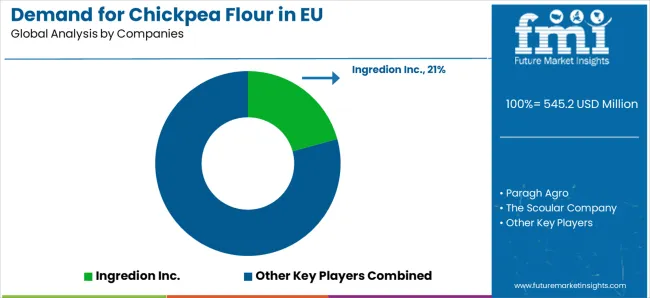
The demand for chickpea flour in EU is defined by competition among multinational food ingredient corporations, regional European manufacturers, specialized pulse processors, and health food companies from major alternative flour suppliers. Companies are investing in European processing capacity expansion, advanced grinding technologies, sustainable chickpea sourcing development through European agricultural centers, quality enhancement solutions aligned with EU food regulations, and direct-to-consumer distribution platforms serving diverse European health-conscious markets.
Strategic partnerships, product portfolio expansion, geographic market penetration across Western European growth markets, professional culinary partnership programs, and quality certifications are central to strengthening market position and capturing share in this developing European category.
Major market participants include Ingredion Inc. with significant European market presence through specialty gluten-free capabilities and comprehensive alternative flour solutions distributed through European health food channels. Paragh Agro maintains substantial European market access through South Asia supply chains and diverse export applications across specialty ingredient sectors including ethnic food and health food markets.
The Scoular Company emphasizes strong protein flour technologies and processing support services for professional food manufacturers across European markets. SunOpta represents European organic market entry with specialized organic processing capabilities and comprehensive sustainable flour technologies.
Regional European producers and specialized health food brands are establishing market presence through premium positioning, organic certifications, specialty chickpea flour formulations including enhanced nutritional alternatives and ethnic cuisine options, and direct-to-consumer business models.
Sustainable agriculture programs from major European food initiatives including established pulse crop programs provide environmentally responsible alternatives supporting market development, capturing market share particularly in sustainability-driven health food markets. European co-processing specialists including specialized pulse processors operate production facilities serving both branded manufacturers and food industry customers, representing infrastructure enabling market expansion and product innovation across European alternative flour markets.
| Item | Value |
|---|---|
| Quantitative Units | USD 1,072.5 million |
| Product Type | Desi, Kabuli |
| Product Claims | Conventional, Organic/Non-GMO |
| Distribution Channel | Specialty Stores, Supermarkets/Hypermarkets, Online Retail |
| Countries Covered | Germany, France, Italy, Spain, Netherlands, Rest of Europe |
| Key Companies Profiled | Ingredion Inc., Paragh Agro, The Scoular Company, SunOpta, Anchor Ingredients, AGT Food and Ingredients, Best Cooking Pulses, Diefenbaker Spice & Pulse, Sharayu Organics, European Regional Processors |
| Additional Attributes | Dollar sales by product type, product claims, and distribution channel, regional demand trends across Western and Eastern European health food markets, competitive landscape analysis with multinational corporations and specialized European alternative flour brands, consumer preferences for desi versus kabuli varieties and organic certification requirements, integration with European gluten-free trends and ethnic cuisine strategies, innovations in processing technologies and nutritional enhancement solutions aligned with EU food safety regulations, adoption of direct-to-consumer models and specialty health food distribution networks across EU markets, regulatory framework analysis and food safety standards, supply chain optimization strategies including sustainable chickpea sourcing partnerships, and market penetration analysis for diverse health-conscious segments and geographic regions throughout European Union member states. |
The global demand for chickpea flour in EU is estimated to be valued at USD 545.2 million in 2025.
The market size for the demand for chickpea flour in EU is projected to reach USD 1,072.5 million by 2035.
The demand for chickpea flour in EU is expected to grow at a 7.0% CAGR between 2025 and 2035.
The key product types in demand for chickpea flour in EU are desi and kabuli .
In terms of product claims, conventional segment to command 86.4% share in the demand for chickpea flour in EU in 2025.






Our Research Products

The "Full Research Suite" delivers actionable market intel, deep dives on markets or technologies, so clients act faster, cut risk, and unlock growth.

The Leaderboard benchmarks and ranks top vendors, classifying them as Established Leaders, Leading Challengers, or Disruptors & Challengers.

Locates where complements amplify value and substitutes erode it, forecasting net impact by horizon

We deliver granular, decision-grade intel: market sizing, 5-year forecasts, pricing, adoption, usage, revenue, and operational KPIs—plus competitor tracking, regulation, and value chains—across 60 countries broadly.

Spot the shifts before they hit your P&L. We track inflection points, adoption curves, pricing moves, and ecosystem plays to show where demand is heading, why it is changing, and what to do next across high-growth markets and disruptive tech

Real-time reads of user behavior. We track shifting priorities, perceptions of today’s and next-gen services, and provider experience, then pace how fast tech moves from trial to adoption, blending buyer, consumer, and channel inputs with social signals (#WhySwitch, #UX).

Partner with our analyst team to build a custom report designed around your business priorities. From analysing market trends to assessing competitors or crafting bespoke datasets, we tailor insights to your needs.
Supplier Intelligence
Discovery & Profiling
Capacity & Footprint
Performance & Risk
Compliance & Governance
Commercial Readiness
Who Supplies Whom
Scorecards & Shortlists
Playbooks & Docs
Category Intelligence
Definition & Scope
Demand & Use Cases
Cost Drivers
Market Structure
Supply Chain Map
Trade & Policy
Operating Norms
Deliverables
Buyer Intelligence
Account Basics
Spend & Scope
Procurement Model
Vendor Requirements
Terms & Policies
Entry Strategy
Pain Points & Triggers
Outputs
Pricing Analysis
Benchmarks
Trends
Should-Cost
Indexation
Landed Cost
Commercial Terms
Deliverables
Brand Analysis
Positioning & Value Prop
Share & Presence
Customer Evidence
Go-to-Market
Digital & Reputation
Compliance & Trust
KPIs & Gaps
Outputs
Full Research Suite comprises of:
Market outlook & trends analysis
Interviews & case studies
Strategic recommendations
Vendor profiles & capabilities analysis
5-year forecasts
8 regions and 60+ country-level data splits
Market segment data splits
12 months of continuous data updates
DELIVERED AS:
PDF EXCEL ONLINE
Europe Chickpea Protein Market Outlook – Size, Share & Forecast 2025–2035
Chickpea Flour Market Analysis - Size, Share, and Forecast Outlook 2025 to 2035
Western Europe Banana Flour Market Analysis by Source, Application, Distribution Channel, and Country Through 2025 to 2035
Western Europe Whole Wheat Flour Market Analysis – Trends, Demand & Forecast 2025–2035
Demand for Bean Flour in EU Size and Share Forecast Outlook 2025 to 2035
Demand for Banana Flour in EU Size and Share Forecast Outlook 2025 to 2035
Demand for Whole-Wheat Flour in EU Size and Share Forecast Outlook 2025 to 2035
Europe Radiotherapy Patient Positioning Market Size and Share Forecast Outlook 2025 to 2035
Europe Polyvinyl Alcohol Industry Analysis Size and Share Forecast Outlook 2025 to 2035
Europe Cruise Market Forecast and Outlook 2025 to 2035
Europium Market Forecast and Outlook 2025 to 2035
Eucommia Leaf Extract Market Size and Share Forecast Outlook 2025 to 2035
Europe Massage Therapy Service Market Size and Share Forecast Outlook 2025 to 2035
Europe Cement Market Analysis Size and Share Forecast Outlook 2025 to 2035
European Union Tourism Industry Size and Share Forecast Outlook 2025 to 2035
Europe Injection Molding Machines Market Size and Share Forecast Outlook 2025 to 2035
Europe Injection Moulders Market Size and Share Forecast Outlook 2025 to 2035
Europe and MENA Generic Oncology Drug Market Size and Share Forecast Outlook 2025 to 2035
Europe Masking Tapes Market Size and Share Forecast Outlook 2025 to 2035
Europe Liners Market Size and Share Forecast Outlook 2025 to 2035

Thank you!
You will receive an email from our Business Development Manager. Please be sure to check your SPAM/JUNK folder too.
Chat With
MaRIA